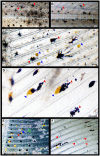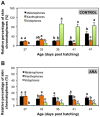Morphological and molecular characterization of dietary-induced pseudo-albinism during post-embryonic development of Solea senegalensis (Kaup, 1858)
- PMID: 23874785
- PMCID: PMC3712922
- DOI: 10.1371/journal.pone.0068844
Morphological and molecular characterization of dietary-induced pseudo-albinism during post-embryonic development of Solea senegalensis (Kaup, 1858)
Abstract
The appearance of the pseudo-albino phenotype was investigated in developing Senegalese sole (Solea senegalensis, Kaup 1858) larvae at morphological and molecular levels. In order to induce the development of pseudo-albinos, Senegalese sole larvae were fed Artemia enriched with high levels of arachidonic acid (ARA). The development of their skin pigmentation was compared to that of a control group fed Artemia enriched with a reference commercial product. The relative amount of skin melanophores, xanthophores and iridophores revealed that larval pigmentation developed similarly in both groups. However, results from different relative proportions, allocation patterns, shapes and sizes of skin chromatophores revealed changes in the pigmentation pattern between ARA and control groups from 33 days post hatching onwards. The new populations of chromatophores that should appear at post-metamorphosis were not formed in the ARA group. Further, spatial patterns of distribution between the already present larval xanthophores and melanophores were suggestive of short-range interaction that seemed to be implicated in the degradation of these chromatophores, leading to the appearance of the pseudo-albino phenotype. The expression profile of several key pigmentation-related genes revealed that melanophore development was promoted in pseudo-albinos without a sufficient degree of terminal differentiation, thus preventing melanogenesis. Present results suggest the potential roles of asip1 and slc24a5 genes on the down-regulation of trp1 expression, leading to defects in melanin production. Moreover, gene expression data supports the involvement of pax3, mitf and asip1 genes in the developmental disruption of the new post-metamorphic populations of melanophores, xanthophores and iridophores.
Conflict of interest statement
Figures








Similar articles
-
Coordinated regulation of chromatophore differentiation and melanogenesis during the ontogeny of skin pigmentation of Solea senegalensis (Kaup, 1858).PLoS One. 2013 May 9;8(5):e63005. doi: 10.1371/journal.pone.0063005. Print 2013. PLoS One. 2013. PMID: 23671650 Free PMC article.
-
Chromatophore distribution and inferior performance of albino Japanese flounder Paralichthys olivaceus with special reference to different chromatophore expression between albinism and pseudo-albinism.J Exp Zool A Ecol Genet Physiol. 2007 May 1;307(5):263-73. doi: 10.1002/jez.372. J Exp Zool A Ecol Genet Physiol. 2007. PMID: 17366621
-
Dietary fatty acid composition affects food intake and gut-brain satiety signaling in Senegalese sole (Solea senegalensis, Kaup 1858) larvae and post-larvae.Gen Comp Endocrinol. 2016 Mar 1;228:79-94. doi: 10.1016/j.ygcen.2016.02.002. Epub 2016 Feb 3. Gen Comp Endocrinol. 2016. PMID: 26851305
-
The physiology of flatfish chromatophores.Microsc Res Tech. 2002 Sep 15;58(6):481-7. doi: 10.1002/jemt.10166. Microsc Res Tech. 2002. PMID: 12242705 Review.
-
Morphological studies on the mechanisms of pigmentary organelle transport in fish xanthophores and melanophores.Microsc Res Tech. 2002 Sep 15;58(6):470-80. doi: 10.1002/jemt.10165. Microsc Res Tech. 2002. PMID: 12242704 Review.
Cited by
-
Understanding pseudo-albinism in sole (Solea senegalensis): a transcriptomics and metagenomics approach.Sci Rep. 2019 Sep 20;9(1):13604. doi: 10.1038/s41598-019-49501-6. Sci Rep. 2019. PMID: 31541115 Free PMC article.
-
Single-nucleotide polymorphisms responsible for pseudo-albinism and hypermelanosis in Japanese flounder (Paralichthys olivaceus) and reveal two genes related to malpigmentation.Fish Physiol Biochem. 2021 Apr;47(2):339-350. doi: 10.1007/s10695-020-00916-3. Epub 2021 Jan 6. Fish Physiol Biochem. 2021. PMID: 33405062
-
Thyroid Hormones Regulate Zebrafish Melanogenesis in a Gender-Specific Manner.PLoS One. 2016 Nov 10;11(11):e0166152. doi: 10.1371/journal.pone.0166152. eCollection 2016. PLoS One. 2016. PMID: 27832141 Free PMC article.
-
Morphological Characteristics and Comparative Transcriptome Analysis of Three Different Phenotypes of Pristella maxillaris.Front Genet. 2019 Aug 2;10:698. doi: 10.3389/fgene.2019.00698. eCollection 2019. Front Genet. 2019. PMID: 31428133 Free PMC article.
-
Analysis of yellow mutant rainbow trout transcriptomes at different developmental stages reveals dynamic regulation of skin pigmentation genes.Sci Rep. 2022 Jan 7;12(1):256. doi: 10.1038/s41598-021-04255-y. Sci Rep. 2022. PMID: 34997156 Free PMC article.
References
-
- Montoliu L, Oetting WS, Bennett DC (2011) Color Genes. European Society for Pigment Cell Research. Available: http://www.espcr.org/micemut Accessed 2013 Jun 10.
-
- Fujii R (2000) The Regulation of Motile Activity in Fish Chromatophores. Pigment Cell Res 13: 300–319. - PubMed
-
- Lister JA (2002) Development of pigment cells in the zebrafish embryo. Micros Res Tech 58: 435–441. - PubMed
-
- Mellgrem EM, Johnson SL (2002) The evolution of morphological complexity in zebrafish stripes. Trends Genet 18: 128–134. - PubMed
Publication types
MeSH terms
Substances
LinkOut - more resources
Full Text Sources
Other Literature Sources

